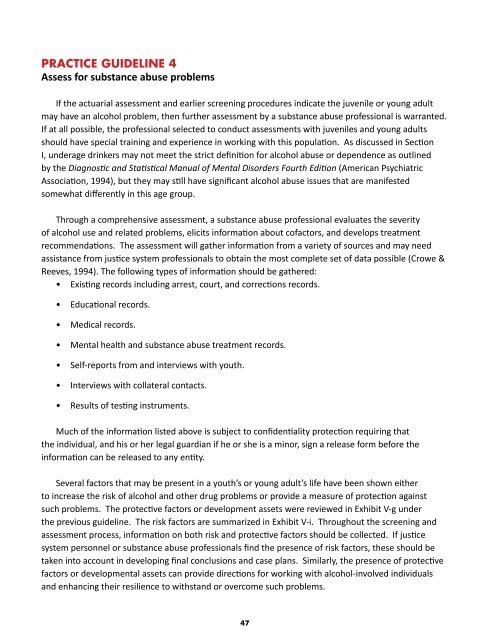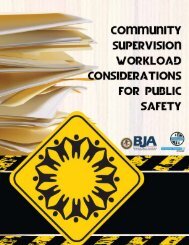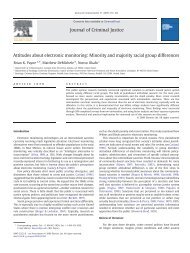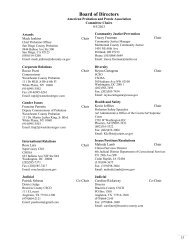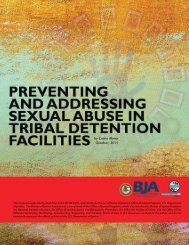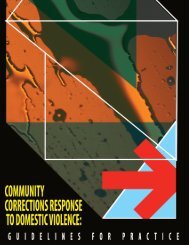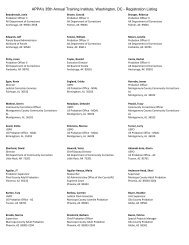Intervention Principles and Practice Guidelines for - Underage ...
Intervention Principles and Practice Guidelines for - Underage ...
Intervention Principles and Practice Guidelines for - Underage ...
Create successful ePaper yourself
Turn your PDF publications into a flip-book with our unique Google optimized e-Paper software.
<strong>Practice</strong> Guideline 4<br />
Assess <strong>for</strong> substance abuse problems<br />
If the actuarial assessment <strong>and</strong> earlier screening procedures indicate the juvenile or young adult<br />
may have an alcohol problem, then further assessment by a substance abuse professional is warranted.<br />
If at all possible, the professional selected to conduct assessments with juveniles <strong>and</strong> young adults<br />
should have special training <strong>and</strong> experience in working with this population. As discussed in Section<br />
I, underage drinkers may not meet the strict definition <strong>for</strong> alcohol abuse or dependence as outlined<br />
by the Diagnostic <strong>and</strong> Statistical Manual of Mental Disorders Fourth Edition (American Psychiatric<br />
Association, 1994), but they may still have significant alcohol abuse issues that are manifested<br />
somewhat differently in this age group.<br />
Through a comprehensive assessment, a substance abuse professional evaluates the severity<br />
of alcohol use <strong>and</strong> related problems, elicits in<strong>for</strong>mation about cofactors, <strong>and</strong> develops treatment<br />
recommendations. The assessment will gather in<strong>for</strong>mation from a variety of sources <strong>and</strong> may need<br />
assistance from justice system professionals to obtain the most complete set of data possible (Crowe &<br />
Reeves, 1994). The following types of in<strong>for</strong>mation should be gathered:<br />
• Existing records including arrest, court, <strong>and</strong> corrections records.<br />
• Educational records.<br />
• Medical records.<br />
• Mental health <strong>and</strong> substance abuse treatment records.<br />
• Self-reports from <strong>and</strong> interviews with youth.<br />
• Interviews with collateral contacts.<br />
• Results of testing instruments.<br />
Much of the in<strong>for</strong>mation listed above is subject to confidentiality protection requiring that<br />
the individual, <strong>and</strong> his or her legal guardian if he or she is a minor, sign a release <strong>for</strong>m be<strong>for</strong>e the<br />
in<strong>for</strong>mation can be released to any entity.<br />
Several factors that may be present in a youth’s or young adult’s life have been shown either<br />
to increase the risk of alcohol <strong>and</strong> other drug problems or provide a measure of protection against<br />
such problems. The protective factors or development assets were reviewed in Exhibit V-g under<br />
the previous guideline. The risk factors are summarized in Exhibit V-i. Throughout the screening <strong>and</strong><br />
assessment process, in<strong>for</strong>mation on both risk <strong>and</strong> protective factors should be collected. If justice<br />
system personnel or substance abuse professionals find the presence of risk factors, these should be<br />
taken into account in developing final conclusions <strong>and</strong> case plans. Similarly, the presence of protective<br />
factors or developmental assets can provide directions <strong>for</strong> working with alcohol-involved individuals<br />
<strong>and</strong> enhancing their resilience to withst<strong>and</strong> or overcome such problems.<br />
47


